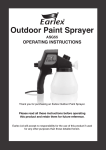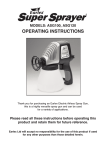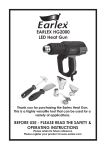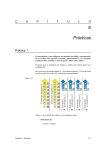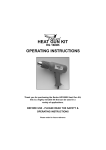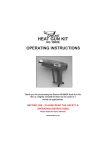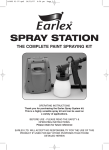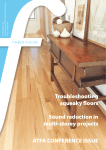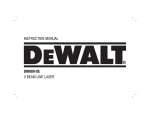Download Earlex ASG55 Operating instructions
Transcript
MODEL ASG55 OPERATING INSTRUCTIONS Thank you for purchasing an Earlex Electric Airless Spray Gun. Please read all these instructions before operating this product and retain them for future reference. Earlex Ltd will accept no responsibility for the use of this product if used for any other purposes than those detailed herein. SAFETY OPERATING INSTRUCTIONS WARNING: When using the Spray Gun, basic safety precautions, including the following, should always be followed to reduce the risk of fire, electric shock and personal injury. Keep work area clean - Cluttered areas and benches Always ensure there is adequate ventilation when invite injuries. spraying. Consider work area environment - Do not expose the Never spray near a source of ignition, e.g. hot spray gun to rain. Do not use the spray gun in damp or wet locations. Keep work area well lit. surfaces, sparks, cigarettes, glowing wires & open flames including appliance pilot flame. Guard against electric shock - Avoid body contact with The spray gun must not be used for spraying earthed or grounded surfaces (e.g. pipes, radiators, ranges, refrigerators). flammable materials having a flash point below 21˚C. Always beware of any hazards presented by the Keep children away away from the spray gun. material being sprayed and consult the markings on the container or the information supplied by the manufacturer of the material to be sprayed, including requirements for the use of personal protective equipment. Do not spray any material where the hazard is not known. When not in use, spray gun should be stored in a dry, high or locked place, out of reach of children. Use the spray gun for the job it was designed for only. Mis-use of the spray gun will invalidate the guarantee. The spray gun must not be cleaned with flammable liquids having a flash point below 21˚C. jewellery, they can be caught in moving parts. Rubber gloves and non-skid footwear are recommended when Check for damaged parts - Before further use of the spray gun, a guard or other part that is damaged should working outdoors. Wear protective hair covering to be carefully checked to determine that it will operate contain long hair. properly and perform its intended function. Check for Always wear a mask when spraying. alignment of moving parts, free running of moving parts, breakage of parts, mounting and any other conditions that may affect its operation. A guard or We recommend the use of eye protection to keep other part that is damaged should be properly hazardous vapours out of eyes. repaired or replaced by an authorized service centre We recommend the use of ear protectors. unless otherwise indicated in this instruction manual. Have defective switches replaced by an authorized Do not abuse the cord - Never carry the tool by the service facility. Do not use the tool if the switch does cord or pull it to disconnect it from the socket. Keep not turn it on and off. the cord away from heat, oil and sharp edges. Warning - The use of any accessory or attatchment, Do not overreach - Keep proper footing and balance other than those recommended in this instruction at all times. manual, may present a risk of personal injury. Dress properly - do not wear loose clothing or Always disconnect from mains supply when not in Maintain tools with care - Follow instructions for use, when refilling the paint container and before cleaning. lubrication and changing the accessories, inspect tool regularly and if damaged, get repaired by an authorized service centre. Avoid unintentional starting, do not carry a plugged in Have your tool repaired by a qualified person – This tool with a finger on the switch. electric tool is in accordance with the relevant safety requirements. Repairs should only be carried out by qualified persons using original spare parts, otherwise this may result in considerable danger to the user. When tool is used outdoors, use extension cords only intended for outdoor use. It is recommended that a RCD (residual current Do not spray any material where the hazard is device) rated at 30mA is fitted into the mains supply socket for added protection against electric shock. not known. Stay alert - Watch what you are doing. Use common Use genuine Earlex parts only. sense and do not operate tool when you are tired. This appliance is not intended for use by persons Never under any circumstances aim the nozzle at (including children) with reduced physical, sensory or mental capabilities, or lack of experience and knowledge, unless they have been given supervision or instruction concerning use of the appliance by a person responsible for their safety. another person or animal. In the event of injury occuring seek expert medical advice immediately. Always keep the spray nozzle in place during use. Never allow the spray nozzle to come in direct contact with the skin. NOISE AND VIBRATION LEVELS The following values were measured in accordance with EN50144-2-7 A-weighted sound power level: 99.9dB(A) Vibration level: 8.824 m/s2 2 PARTS AND ACCESSORIES 1/2 7 4 3 5 6 1. 2. 3. 4. 5. 1.0mm Nozzle 0.6mm Nozzle Piston Spring 55W Piston Assembly Suction Tube and Filter Assembly 9 8 SG209 SG211 SG234 SG237 SG240 6. 7. 8. 9. 1.0 Litre Paint Container Valve Assembly - Pack of 3 Viscosity Cup Lubricating Oil * Circled numbers need to be cleaned after every use. 3 SG242 SG310 SG243 SG244 ABOUT THE SPRAY GUN TO OBTAIN THE BEST RESULTS FROM YOUR SPRAY GUN READ THESE INSTRUCTIONS CAREFULLY BEFORE USE. The Spray Gun can be used to spray many different materials including varnishes, wood preservatives, enamel paints, oil based paints and water based paints. The Spray Gun can be used for a variety of applications including, fences, sheds, boats, furniture, radiators, models and louvre doors. PLEASE NOTE We have done all we can to ensure that used correctly and according to these instructions, the Earlex Electric Airless Spray Gun will give long trouble free service. We accept no responsibility for damage caused by the use of incorrect or unsuitable substances, paint or fluids which have not been thinned correctly or are unsuitable for the surfaces to which they are applied, health hazards arising from lack of ventilation when working in confined spaces, or failure of the equipment due to inadequate cleaning of components after use. If in doubt, always test a small inconspicuous area first. Always read the paint manufacturer’s instructions first. Neither our guarantee nor the above statement affect your statutory rights. IMPORTANT - Selecting the paint Many paints and other materials can be sprayed but some cannot. Always check the manufacturer’s recommendations before using products with your Spray Gun. THE SPRAY GUN MUST NOT BE USED FOR SPRAYING EXTERIOR TEXTURED WALL PAINTS OR TEXTURED COATINGS. USING THESE MATERIALS WILL CAUSE PREMATURE WEAR ON THE PISTON AND WILL INVALIDATE YOUR GUARANTEE. IF YOU HAVE ANY PROBLEMS WITH YOUR SPRAY GUN OR IF YOU BELIEVE A PART IS MISSING, DO NOT RETURN TO STORE. PLEASE CONTACT EARLEX LTD ON 01483 454666. SAFETY WARNING LABEL One of the labels on the Spray Gun is a warning label and shows three diagrams. If you are in any doubt about their meaning, please see the explanation below: Do not direct the Spray Gun at yourself or anyone else. (Risk of injection). Do not use your Spray Gun in wet weather. 4 <21˚C Do not use your Spray Gun for spraying flammable materials. i.e those with a flashpoint less than 21˚C. PREPARATION Preparation of the surface and thinning of the paint are the two most important areas to be concerned with to obtain the best results from your Spray Gun. Ensure all surfaces are free from dust, dirt, rust and grease. If necessary rub down with sandpaper, or similar. Mask areas you do not wish to be painted. THINNING Your Spray Gun is supplied with a Viscosity Cup. Viscosity is a technical term used to indicate if the paint is very thin or very thick. If thin, the viscosity is said to be low, while if very thick the viscosity is said to be high. Viscosity is measured in seconds. In order to spray some paints they need to be “thinned” (diluted). Thinning is very important when spraying. Most paints are supplied ready for brush application and may need to be “thinned” (diluted) for spraying purposes. Follow the manufacturer’s guide for thinning. If in doubt please contact the manufacturers of the paint. The Viscosity Cup supplied will help you determine the correct thickness of the paint. Paint is “thinned” by adding the substance which the paint is based upon. If water based paint then water is added, if oil based then white spirit, if automotive paint then an automotive paint thinner is added. As some paints, wood preservatives and other sprayable products contain particles, please ensure that when filling the Paint Container of the Spray Gun, that the paint is filtered through either a funnel with a filter on it or through nylon tights or stockings. This will ensure that no large particles enter the Paint Container, so preventing blockages and providing you with trouble free spraying. Ensure that a facemask, gloves and goggles are worn at all times when spraying. VISCOSITY GUIDE Water based paints Oil based paints Enamel paints Wood preservatives 20-25secs 15-25secs 15-25secs no dilution Primers Varnishes Aluminium paints Wood stains 20-30secs 20-25secs 15-25secs no dilution This Spray Gun can be used with paints having a viscosity ranging from 15 to 30 seconds. Dip the Viscosity Cup into the material and fill up. Time how long it takes for the viscosity cup to empty (Fig.1). Using the above chart (or manufacturer’s instructions) as a guide, determine if the material requires further thinning, if so then thin accordingly. Important: Before you begin to thin the paint, ensure it is stirred thoroughly. Fig.1 If the paint requires thinning, start with a 10% dilution of the paint. To do this, half fill the paint container with the required paint. The Viscosity Cup supplied with the unit holds 1/10 of a litre, block the hole in the Viscosity Cup and fill up with the required thinner. Add the thinner to the paint and stir, measure the viscosity using the recommended viscosity chart above. If the paint requires further thinning, dilute the paint by another 5% (5% will be equal to half a viscosity cup) with the required thinner and measure the viscosity, if the paint is not at it's recommended viscosity, repeat the above step. Note: Some paints are outside the ranges listed above. Please contact our helpline for further information. 5 PREPARING AND USING YOUR SPRAY GUN OI L SAFETY WARNING! DO NOT SPRAY FLAMMABLE MATERIALS (FLASH POINT < 21˚C). ALWAYS SPRAY IN A WELL VENTILATED AREA. NEVER SPRAY NEAR NAKED FLAMES. ALWAYS WEAR PROTECTIVE FACE MASK, GOGGLES, GLOVES & EAR PROTECTORS WHEN USING YOUR SPRAY GUN. MASK THE AREAS OF THE ITEM THAT YOU DO NOT WANT TO SPRAY AND PROTECT ANY ADJACENT AREAS THAT COULD BE AFFECTED BY OVERSPRAY. OPERATION Turn the gun upside down and place a few drops of Lubricating Oil (9) in both Fig.2 the apertures on the underside of the Spray Gun (see Fig.2). Connect to mains and momentarily trigger the Spray Gun to disperse the oil around the piston and cylinder, then disconnect the ASG55 from the mains and firmly push the Suction Tube (5) into the tapered hole of the raised boss. Fill the Paint Container with the paint, filtering the paint through a piece of nylon stocking or a funnel which incorporates a filter to remove any lumps or particles. DO NOT OVERFILL. Screw the Spray Gun on to the Paint Container tightly. Ensure the Nozzle (1/2) and clamping knob are hand tightened before use. Plug in the unit and before you start depress switch fully, aiming the Spray Gun at a piece of cardboard or newspaper until the paint comes out. Adjust the output control knob on the back accordingly to control the volume of paint that you wish to apply (Fig.3). This will also affect the spray pattern. A poor spray pattern will concentrate the paint in the centre of the spray and give a blotchy finish. A good spray pattern is achieved when there is an even amount of material in a fine spray throughout the pattern. USING THE OUTPUT CONTROL KNOB Turning the output control knob clockwise reduces the flow of material whilst turning it anti-clockwise increases the flow. To adjust the pattern undertake the following: 1. Turn the output control knob anti-clockwise to the maximum position. 2. Pull the trigger and test the pattern on a piece of cardboard or newspaper. 3. Turn the output control knob clockwise from the maximum position until the spray pattern is correct. Fig.3 If you have undertaken the above and you still cannot obtain a good spray pattern then the material being sprayed probably requires further thinning. SPRAYING TECHNIQUE To obtain best results keep the Spray Gun level and square to the surface being sprayed. The Spray Gun works best if the Nozzle is kept about 25 – 30 cms (10” – 12”) from the surface being sprayed; (See Fig. 4) This will result in consistent, even coverage. To avoid overlap of the paint and therefore uneven coverage, we recommend that the Spray Gun be momentarily turned off whenever you change direction. Move the Spray Gun at an even speed. A fast speed will give a thin coat and a slow speed will give a thicker coat. Never tilt the spray gun more than 45˚ as this could result in paint getting into the motor and cause serious damage. Fig.4 6 HELPFUL HINTS 1) Only apply one coat at a time. If more than one coat is required follow the paint manufacturer’s instructions for drying times. 2) If spraying small objects keep the output setting low as this will avoid excessive use of paint and will minimise overspray. 3) When spraying large areas or objects use a criss-cross pattern either left to right then up and down or vice-versa. Remember to momentarily stop spraying as you change direction. This will ensure maximum coverage. (See Fig. 5) 4) Avoid stopping and starting when spraying as this can lead to too much or not enough material on a surface. 5) To ensure edges are covered begin spraying just outside the area being sprayed and do not stop until you have just passed the opposite edge. Fig.5 SPRAY NOZZLE SELECTION The ASG55 Spray Gun is supplied with 0.6mm and 1.0mm nozzles. 1) 0.6mm - This size works best for oil-based materials, stains, sealers, lacquers, water-proofers and enamels for small application areas. 2) 1.0mm - This nozzle is suitable for spraying woodcare treatments. If when spraying you find that the spray pattern is small and splattery, and adjusting the output control knob does not solve the problem, try a different nozzle size before further thinning the material. GENERAL CLEANING INSTRUCTIONS After every use it is essential that you clean the Spray Gun thoroughly When you have finished spraying, empty any remaining material out of the Paint Container and clean it thoroughly using the thinners required for the job. Rinse the Spray Gun Paint Container with the thinners required for the job and spray through the Spray Gun onto cardboard or newspaper, and follow the instructions below. Refer to spare parts section on page 3 when carrying out the following. When you have finished spraying, empty any remaining material out of the Paint Container. 7 Rinse the Spray Gun Paint Container with the thinner that was used and spray through the Spray Gun onto cardboard or newspaper. Remove the top knob, slightly push the nozzle towards the switch and pull down and forward to release the piston cylinder assembly from the main Spray Gun assembly. Take care not to allow the piston assembly and spring to fall out. Remove the piston assembly and spring, unscrew the spray nozzle to release the Valve Assembly, pull out Suction Tube and unclip filter. 8 Submerge all of the components into a cleaning fluid compatible with the fluid being sprayed. Thoroughly clean all of these parts. Lightly oil the piston and slide it in and out of the cylinder to distribute the oil over the mating parts, reassemble all of the components to their original positions. MAINTENANCE AND REPAIR Please be aware that certain parts of this Spray Gun will wear, requiring replacement and that these parts are not covered by guarantee. These parts include the Valve Assembly (7), Nozzle (1/2), Piston and Spring (3/4). The wear on these parts depends on the abrasiveness of the paints being sprayed. You would normally expect to replace an atomiser valve after spraying between 25-45 litres of emulsion. A worn valve will cause a poor spray pattern and will require replacing. Replacement valves are available from the Earlex Service Department (see page 11 for contact details). You will need to check the spray nozzles, Piston and Spring from time to time to check for wear. Replace if necessary. NEVER DISPOSE OF PAINTS OR SOLVENTS INTO DRAINS. CONTACT YOUR LOCAL COUNCIL TO ARRANGE COLLECTION. 9 TROUBLESHOOTING PROBLEM Spray Gun hums but does not operate No suction feed Spray Gun motor operates, but nothing comes out Spray Gun motor operates but spluttering Paint dripping from Nozzle Excessive overspray Runs and sags in paint CAUSE Piston sticking (4) Liquid too thick No Valve Assembly (7) Paint Suction Tube and Filter Assembly (5) ACTION REQUIRED Remove the large knob at the top of the unit. Pull Nozzle and Piston Assembly down and back to release from main gun assembly. Unscrew and remove Nozzle. Remove Valve Assembly. Insert the metal punch, supplied in the spares pack, into the front of the cylinder housing and gently tap the punch to eject the seized piston. Clean and lubricate piston and cylinder. Re-assemble carefully in reverse order. Remember to replace the compression spring onto the piston before fitting the piston. Ensure you have not dropped any parts into main Spray Gun assembly. Thin liquid as recommended or contact paint manufacturer Remove Nozzle, and insert Valve Assembly and refit Nozzle Clean filter Nozzle blocked part (1/2) Clean thoroughly with thinners or if water based paint, clean with water. Clean thoroughly with thinners. Paint Container almost empty Spray Gun held at wrong angle Liquid too thick Incorrectly set regulation control Incorrect Nozzle fitted Worn Nozzle (1/2) Refill Paint Container Nozzle Valve Assembly blocked (7) Worn Valve Assembly (7) Nozzle loose Spray Gun held at more than 45˚ Pressure too high Holding Spray Gun too far from surface Arm movement too slow Spray Gun too close to work surface Applying too much paint in one go Hold at correct angle Thin liquid as recommended Adjust regulator at back of Spray Gun Replace Nozzle with other size Replace Nozzle Replace Valve Assembly Tighten Nozzle Keep Spray Gun upright Turn output knob clockwise to reduce pressure. Hold Spray Gun about 25-30cm (10”-12”) from work See section on spraying. (See page 6 and 7). 10 MAINS CONNECTION This unit is a Class II appliance which means it is double insulated for your protection, no earthing wire is necessary. If the supply cord is damaged, it must be replaced by Earlex Ltd or our appointed agents. Your unit has been supplied with a mains lead with a fitted fused plug. Please read the following safety instructions before use. 1. If the fitted plug is cut off from the mains lead then the plug must be disposed of safely. NEVER under any circumstances insert such a plug into a 13 Amp socket. 2. NEVER under any circumstances use the appliance or mains lead without the fuse cover fitted. This is the little cover fixed into the base of the plug to hold the fuse in place. 3. If you lose the fuse cover then please contact any electrical dealer for a replacement or ring our helpline. 4. A replacement fuse must be rated at 5 Amp. These must be manufactured and approved to BS 1362. 5. IF IN ANY DOUBT CONTACT AN ELECTRICIAN. If you need to fit a plug to the mains lead, this should be fitted in accordance with the wiring instructions below, and will need to be used with a 5 Amp fuse. If in doubt consult an electrician. If you are using an extension lead it must be rated at a minimum of 6 Amps and fully unwound. Do not operate with a lead rated at less than 6 Amps as this will cause premature failure of the motor which is not covered by the guarantee. EARLEX LTD. WILL ACCEPT NO RESPONSIBILITY FOR THE USE OF THIS PRODUCT IF USED FOR ANY OTHER PURPOSES THAN THOSE DETAILED HEREIN Information on the disposal of waste electrical equipment known as WEEE: Your attention is brought to new directives applicable to the disposal of this electrical equipment, where in accordance with the legislation this product must not be disposed of in your normal household waste. Instead it is your responsibility to dispose of this type of waste by handing it over to special designated collection points for recovery and recycling. This product is marked with a ‘Wheelie bin’ symbol with a cross on it to remind you of this action. The objective of this directive is to help conserve resources and ensure that it is recycled in a manner that protects human health and the environment. For more information about where you can drop off your waste please contact your local authority, take back facilities are free of charge. GUARANTEE This product is guaranteed for a period of 12 months against faulty manufacture and materials. It is not guaranteed for industrial or hire purposes. The guarantee does not affect your statutory rights. For further information please contact us on our Helpline No between 08.30 a.m. and 5.00 p.m. Mondays to Fridays (excluding Bank Holidays) or visit our Website on www.earlex.co.uk HELPLINE No 01483 – 454666 British Registered Design No’s: GB 2097621, DE 4103820.3, FR 013052, US 29/141,500 Copyright & Design Right Reserved 2009© EC Declaration of Conformity We declare that the units ASG55 conform to: 2006/95/EC, EN50144-1, EN50144-2-7 2004/108/EC, EN61000-3-2, EN61000-3-3, EN55014-1, EN55014-2. Tim Hopper-Technical Director © Earlex Ltd 2009 Earlex Ltd., Opus Park, Moorfield Road, Guildford, Surrey, GU1 1SZ. Tel: 01483-454666 Fax: 01483-454548 email: [email protected] website: www.earlex.co.uk 11 SG216 01/09 NOTES












